CAT | LED Tubes
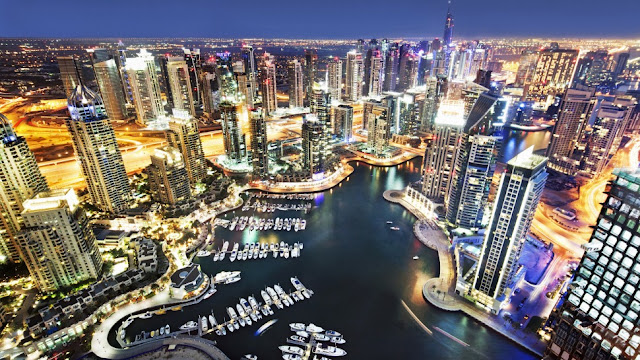
The new ruling means that all new buildings will have to feature LED lighting.
Fitting Philips ‘Dubai Lamp’, will be made the basic requirement for getting a Building Completion Certificate in Dubai.
Philips struck up a good deal!.. All new buildings in Dubai will soon be compelled by law to install specific LED lamps, the municipality has ruled, after striking a deal with Philips Lighting to supply millions of light sources to the emirate.
Authorities in Dubai signed a five-year contract with Philips to create the ‘Dubai Lamp’, which, it it is claimed, will be the first commercially available 200 lumen per Watt LED lamp.
The new fixtures will replace 80 percent of traditional lights currently in the emirate’s residential buildings, and, as of this year, all new buildings constructed in the city will have have to feature the Philips LED.
Fitting LED in new buildings will be made the basic requirement for getting a Building Completion Certificate, by the end of this year.
The initiative will initially focus on new buildings and big complexes such as schools, hospitals, mosques and shopping centres. A study will also be undertaken to develop a strategy of implementation for older buildings, in an attempt to ensure that the scheme ensures a wider legacy and that energy savings and a positive environmental impact continue to grow overtime.
Philips has been commissioned by the Dubai authorities to manufacture and supply two million of the ‘Dubai Lamps’, which will not contain mercury or generate heat. The Dubai Municipality plans to install 10 million Dubai Lamps before the end of 2021.
‘It will be made the basic requirement for getting a building completion certificate. This will be beneficial for both sides. The owner of the building will be able to save a lot of money on energy charges and we will able to protect the environment,’ Hussain Nasser Lootah, director general of Dubai Municipality, told The National.
‘In the beginning, we will concentrate on new buildings and we will complete a study of old buildings to see what can be done.’
Lootah said the latest agreement which is in line with government directives, supported the Dubai Integrated Energy Strategy, which targets a 30 percent reduction in energy consumption by 2030, and the Dubai Carbon Abatement Strategy, which is aimed at reducing carbon emissions by 16 per cent by 2021.
The lamps will be available in four models, both in cool daylight and warm white colours. That includes 1W candle lamps to replace the 25W incandescent lamp, 2W bulbs to replace 40W incandescent lamps, 3W bulbs to replace 60W incandescent lamps, and the 3W MR16 Spot to replace 50W halogen spots.
Novel Energy Lighting supplies the full range of Philips LED lamps, tubes, and luminaires. Please visit us today, or email: sales@novelenergylighting.com or call (0208-540-8287) to discuss you project needs.
dubai lighting · LED lamps · Novel Energy Lighting · philips led · Philips LED bulbs · philips led luminaires · Philips led panels · philips led tubes · philips lighting
Thorn Lighting is helping to sponsor the “Sleepless Light Exercises” exhibition at The Canterbury Festival this year by supplying PopPack T26 Batten luminaires for use on a sculpture.
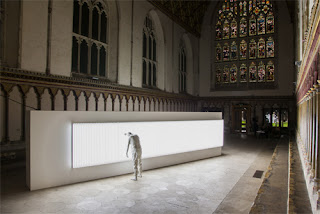
The annual event, which is taking place at the Chaper House in Canterbury Cathedral, is one of the most important cultural and contemporary art events to be held in the South East of England.
The exhibition by international artist Bernardi Roig, working with the University of Creative Arts (Canterbury), uses life size sculptures made from polyester resin leaning against a wall and covered in 200 of Thorn’s PopPack 58W Battens. The stark white of the sculpture, combined with the powerful illumination from the fluorescent lamps, creates a dramatic contrast within the surrounding Gothic stained glass window space. Roig’s work explores themes such as human isolation, loneliness, the limits of knowledge and the body’s deterioration. The artist has created a tense relationship between figure and background, between rational comprehension and spiritual understanding, between artificial light and divine clarity.
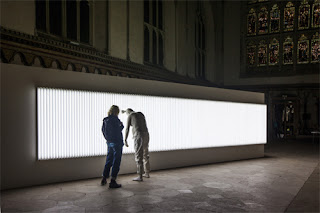 Emma Braso, Cultural Programme Curator at University for the Creative Arts, commented “We are delighted that Thorn has supported this event, the fluorescent lighting is a perfect choice of illumination for this exhibition as it creates a dramatic impact”.
Emma Braso, Cultural Programme Curator at University for the Creative Arts, commented “We are delighted that Thorn has supported this event, the fluorescent lighting is a perfect choice of illumination for this exhibition as it creates a dramatic impact”.
Thorn’s PopPack Batten incorporates a Tridonic PC T8 Pro ballast contained in a white stoved enamel outer to provide a colour rendering index of 80 and luminaire efficacy of 90 lm/w. The 1500mm luminaire is suitable for a wide range of applications, including unique exhibition displays such as the Sleepless Light Exercises.
church led · church lighting · led ligthting · led tubes · Novel Energy Lighting · poppack led · thorn led · thorn lighting · thorn poppack
The lighting industry is gearing up to launch a key weapon in the war on the deadly Zika virus – special LED lights.
Fred Maxik, the chief technology officer of Lighting Science, is exploring the possibility of constructing a special trap for the mosquito which carries the life-threatening infection.
Fred Maxik, the chief technology officer of Lighting Science, says the key is to create specific light that’s useful for our own purposes.
Transmitted via a bite from the yellow fever mosquito, Zika is extremely serious for pregnant women, as there’s evidence it causes birth defects such as abnormally small heads. Experts now warn that they expect the Zika virus to spread to all countries in the Americas, including the Caribbean, except Chile and Canada.
Lighting Science – which uses special tuned lighting for applications such as water purification, turtle protection and space use – is developing a tuned light trap for the yellow fever mosquito. The company is already working with the US Department of Agriculture on its programme of light-based insect traps. With a little modification, it thinks it can develop one specially to help in the war on the Zika virus.
This is because different mosquitos are attracted to different wavelengths of light. By ‘tuning’ the light specifically at the yellow fever mosquito – or Aedes aegypti, to give it its scientific name – the light traps can be targeted.
‘There’s no one size fits all,’ Maxik told Fortune magazine this week. By testing the traps in the field, the company can work out exactly which spectral signature attracts and which repels the creatures. Special lights can then be developed to deter the mosquitoes from approaching buildings such as ante-natal clinics and hospitals in high-risk zones. ‘We’re trying to create light that’s useful for our own purposes.’
LED lamps · led lighting · led tubes · Novel Energy Lighting · tunable light · zika virus
GE to deliver energy savings of more than 50% and cut greenhouse gas emissions by more than 7,000 tonnes annually with Santander lighting infrastructure upgrade
Demonstrating that corporations no longer have to choose between ‘profit and planet’, GE has delivered a cash-positive lighting infrastructure upgrade for the UK business of global banking institution Santander.

Lux reports: As the UK’s biggest ever fully-funded LED lighting retrofit, the project will see 90,000 new lights installed across the bank’s UK estate of 800 branches and 13 office buildings – slashing energy use in half and reducing carbon emissions by more than 7,000 tonnes each year.
Providing a full scope solution, GE will deliver lighting services throughout the 10-year contract, which includes optimised system design, installation, maintenance and management.
Importantly, the project is to be delivered using a cash-positive financing model, in a move that is set to reinvent the way people (companies?) think about investment in energy efficient lighting upgrades. The model includes a substantial investment of £17.5 million by the UK Green Investment Bank plc and Sustainable Development Capital Limited, making it the biggest LED-financing package the UK has ever seen.
This unconventional approach, in which the financing partners enable the lighting to be procured as a service rather than a product purchase, allows Santander to benefit from the reduced operating costs and improved energy efficiency of the LED lighting but without the capital investment and impact on the balance sheet – a flexible solution that could pave the way for many other organisations to follow suit.
Dan Vinton, CFO GE Lighting EMEA at , commented: “The lighting industry has changed dramatically in the last few years, moving away from supplying product as a simple disposable commodity, to providing high value solutions to customers while becoming a true energy efficiency partner. The old models of the lighting industry are no longer fit for purpose in this new market and this project represents a glimpse into the new world.”
“More than anything, this project has been about listening to our customer’s needs and working with them to develop a tailored package of lighting and finance solutions that perfectly meet their requirements. The strength, credibility and expertise represented by the GE brand helped make the project bankable which was a key element of success. We’re privileged to have been able to walk this learning journey together with our partners and proud of what we have accomplished here. We are now focused on scaling this offering more broadly and allowing more customers in our target markets and verticals to benefit from this type of smart value creation.”
Nick Roberts, Property Director, at Santander, said: “We launched our 20-20-15 energy efficiency strategy three years ago, in which we committed to reducing energy consumption and CO2 emissions by 20 per cent by 2015. LED lighting has become an integral part of our Energy Efficiency Plan and plays a key role in achieving these overall sustainability goals. Through this lighting upgrade we have taken a huge step forward in executing our long-term efficiency objectives, with GE providing the support, scale and suitable products that we needed.”
Visit www.novelenergylighting.com today to explore what LED can do for you. Distributors for all major brands, including GE LED. Call today for project pricing and financing details: 0208-540-8287, or email: sales@novelenergylighting.com
ge led · ge lighting · LED lamps · led lighting · led panels · led tubes · lighting project finance · lux · Novel Energy Lighting · santander led retrofit
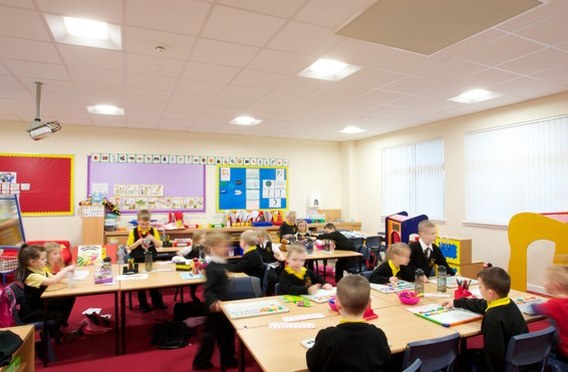
Education is no longer about teaching; it is about creating a stimulating learning environment. Or to put it another way the quantity of information given out by a teacher is less important than the amount of information taken in by a student. This shift in emphasis has impacted the design of education buildings. Previously they were designed around the needs of the teacher whereas they are increasingly designed around the needs of the student. This requires more flexible spaces suitable for formal teacher led sessions and also for less formal group discussions and breakout sessions.
Building design has also developed as the importance of daylight to learning rates and attendance levels has begun to be understood. Therefore modern learning spaces tend to receive significant levels of daylight which in turn leads to significant energy savings in well-designed lighting installations.
Best practice
The European Standard EN 12464-1:2011 Light and lighting – Lighting of work places Part 1: Indoor work places provides recommended lighting levels for academic buildings. However whilst important these recommendations address only a part of the lighting requirements. Education is a communication centred discipline and lighting of people so they appear friendly and so that body language is readily visible is important, as is facilitating the use of all presentation materials and formats. EN 12464-1:2011 also provides recommendations for cylindrical illuminance to ensure good lighting of verticals, 150lx at 1.2m height. It discusses the modelling index, the ratio between the horizontal and vertical flow of light, to provide the correct balance between light and shade. It also highlights the importance of lighting room surfaces to make a space feel light and airy and prevent a sensation of gloom, recommending an average illuminance of 75lx on the walls and 50lx on the ceiling.
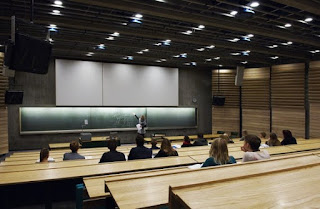
Education should always be centred on the needs of people and care should be taken not to design spaces for technology at the expense of comfort. However in some areas of high DSE use care should be taken to take account of the effect of lighting on screens. Recommendations for lighting for DSE are provided in the European Standard EN 12464-1:2011 Light and lighting – Lighting of work places Part 1: Indoor work places. However these criteria are for general computer technology and if plasma screen technology is used tighter control of luminaire brightness should be considered. Ideally the balance between lighting for people and lighting for technology should be achieved by intelligent use of lighting controls and scene setting to allow lighting to be adjusted to the needs of the moment.
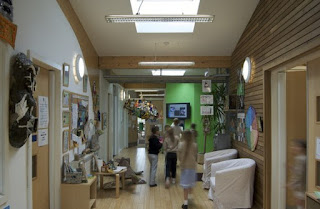
Taking control
Supplying comfortable and effective light is not the same as supplying controlled and energy-efficient light. A lighting system should interact with the space, dimming in response to increasing levels of daylight, turning on or off in response to occupancy within the space, and with increasing use of technology and the need for flexibility of learning styles allow lighting scenes to be set to provide the optimal conditions for the needs of the task at hand. Lighting should be an integral part of the space ambience, giving a calm or lively atmosphere dependant upon the needs of the subject, providing an inspiring and stimulating environment for students and staff.
Visit www.novelenergylighting.com to explore LED lighting retrofit options for your school or university project. Please call us to discuss options or arrange for light designs: tel. 0208-540-8287, email: sales@novelenergylighting.com
LED downlights · led lighting · led panels · led tubes · Novel Energy Lighting · school led · school lighting · university lighting
There are many easy ways facility managers can make fast and permanent changes to their lighting that will save on energy, slash maintenance and give quick paybacks. Swapping traditional technologies for LED is the easiest of all…
There must be things that the hard-pressed facilities manager can do to make their job just a little bit easier, and maybe save a bit of money for better things. Here’s a list of actions that shouldn’t take too much effort to work out and which should see immediate benefits.
Replace 2D lamps with LED modules
There’s no reason why utility bulkheads in service areas should still be fitted with 2D fluorescent lamps. There are plenty of efficient LED alternatives designed specifically to replace the 2D lamp. They’ll provide around 70% energy savings, with improved light output across a lamp life of around 50, 000 hours.
But be careful and do a bit of research. Switching from a fluorescent 2D lamp to an LED retrofit isn’t only an easy fix for you; it’s also an easy option for unscrupulous manufacturers and suppliers, so be sure of who you’re dealing with.
Eliminate all tungsten lamps
There may be a very special reason why THAT filament lamp needs to stay in THAT fixture in THAT room, but otherwise there really is no excuse to be holding onto any filament lamps.
Let’s remind ourselves of the facts: tungsten and tungsten halogen lamps operate at around 10 – 20 lm/W, compared with LED retro-fit lamps that start at 60lm/W and only get better. And some of those LED lamps can be dimmed, making the savings even greater.
The usual warning about LED product needs to be aired here. There are companies out there who just want to take your money and offer very little in return apart from problems. Make sure that you know who you’re dealing with when it comes to LED retro-fit lamps.
Swap out T12 fluorescent tubes
Extraordinarily, it’s still possible to buy T12 fluorescent lamps, because there are still companies making them. It’s like calling into a Ford dealership and being offered a Cortina. The only reason for still using a T12 fluorescent lamp is because no one’s got round to changing those 1800mm and 2400mm battens that were installed thirty years ago.
So, on the grounds that anything else is better than a T12 lamp (except a filament lamp) it’s time to replace the old fixtures with some modern technology. These days that will mean a one-for-one replacement with either an LED fixture or a T5 fluorescent equivalent, depending on which gives you the better performance for the task.
Install presence sensors in toilets
Lights being left on when rooms are vacant is just wasted energy. The simplest fix is to install a movement sensor on the ceiling, wired between the light switch at the door and the light fittings. Then all you need to do is to change the wall-switch to a secure key switch – and leave it in the ON position.
The sensor will detect when someone comes into the toilet and switch on the lights automatically. So far, so easy, but there is one issue that always needs to be taken care of – its no comedy when the lights go out and you’re tucked away in a cubicle. Good sensors are fitted with adjustable time-settings to avoid embarrassment.
Fit absence detectors where you can
If we accept the argument that lighting an empty room is a waste of energy, then we might shift our attention to an energy management structure that might bring savings from working spaces beyond the toilets.
The quick fix is to accept that every room needs to be taken on its merits and provide such energy saving technology as may be relevant. Don’t get hung-up on an estate-wide solution; do what you can and what makes sense.
The common situation is that a room is vacated and stays empty for a decent length of time, with the lighting left ON. Installing absence sensors into the lighting circuit ensures that an empty room automatically switches to an unlit room. Absence detectors switch the lighting off but do not switch the lighting back on when someone comes into the room; that decision is left with the occupants.
The only gripe about absence detectors is that they promote lazy thinking – see ‘education’ below.
Use daylight controls
Most of the time we’re thinking about saving energy from artificial lighting after dark, or in rooms where there is little or no natural light. But, where its available, natural light equals free illumination.
The easy catch is the area along windows where daylight ingress will exceed interior light levels for much of the day. What happens next depends on the state of the ceilings. If rooms are fitted with a suspended ceiling system then there is a readily available easy fix. Install daylight sensors along the window line and create two zones, one that is lit 100% by artificial lighting, while the other benefits from available daylight.
There are varying levels of sophistication around daylight controls, with some buildings controlled so that each run of light fittings (parallel to windows) has separate control. That may be a step too far, but there’s no need to walk away from the idea when a simplistic option is available.
Manage your exterior lighting
This calls for a bit of analysis but can give you a satisfying return on the effort. All external areas can be assessed by their usage and their security needs. A space that is in use at all hours and has serious security requirements will need lighting throughout the hours of darkness, and will probably be supported by a CCTV system. On the other hand, a back-of house loading area that is only ever in use during normal working hours and which is otherwise inaccessible may need nothing more than some low-level security lighting that can be triggered by sensors.
Working through the estate, zoned lighting installations can be retro-fitted with sensors and time-switches to guarantee energy savings, and probably make life for those in neighbouring properties a bit more comfortable.
Swap emergency bulkheads for self-test luminaires
The emergency lighting regulations require regular testing of the emergency lighting installation. In a large estate this has been compared to painting the Forth Bridge and it’s not surprising to hear that some installations receive only the minimum attention needed to stay on the right side of legal.
The easiest fix is simply to remove the old self-contained luminaires that are controlled via a key-switch by the door and replace them with luminaires that contain internal circuitry that enables the luminaire to monitor itself. Regular checks then only require a visual check of the LED display on each fitting, making life far easier for technical staff.
An important note, though. You’ll still have to carry out the annual real-time inspection. Getting free from that chore requires a far more complex solution.
Educate your occupants
The most cost-effective method of energy management is to have knowledgeable building users who understand the implications of lights being switched on and left on when it’s not necessary. The best type of sensor is the person with their finger on the light switch.
Of course, the potential hazard lurking behind any kind of well-intentioned behavioural training is that you end up alienating exactly those people you need to encourage. Teaching staff members to be more alert to energy management needs careful handling; but once the argument is won, the benefits are there for a long, long, time.
Oh, and clean your fittings!
Once all is said and done, and the installation is working well, with all the sensors fitted and staff members on-message there’s still one thing to get to grips with, and that is cleaning.
Most commercial and industrial light fixtures are technical constructions. They have reflectors and diffusers and these will need regular cleaning if the light levels aren’t to fall below acceptable standards. What ‘regular cleaning’ means in practice will be determined by local environment and health & safety factors. Clean Rooms are probably already being kept in an immaculate state, but back-of-house service areas are possibly running at less than the optimum level.
A good cleaning regime means that money is not being wasted by dust and grime stopping that expensive light getting out of the fixture.
Call us to discuss lighting for your premises: 0208-540-8287. Visit www.novelenergylighting.com to explore our range of LED downlights, LED tubes, LED panels, and sensors.
facility management · FM · led 2d · LED downlights · led lighting · led panels · led tubes · lighting · Novel Energy Lighting · occupancy sensors · PIR sensors
Modern offices are increasingly dominated by display screen technology. Whilst appreciable quantities of paper documents are still in use they are normally in association with computers, and this balance is gradually moving toward increasing display screen use and decreasing quantities of written or printed text. A side-effect of this is the reduction in the amount of filing requirements as documents are stored on a computer disk.
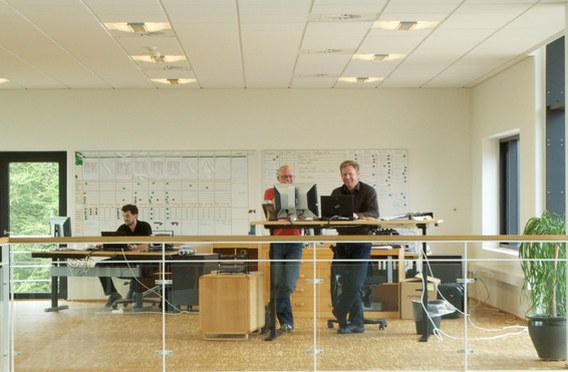
This has resulted in a change in office furnishings with fewer storage cabinets and an increase in technology, and also in a fundamental shift in task position, from predominantly horizontal documents to predominantly vertical display screens.
Additionally in many offices collaborative working is encouraged where formal or informal face-to-face discussions occur to consider short-term issues or long-term plans.
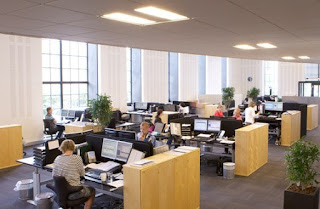
Building design has also developed as energy costs and sustainability issues gain importance, resulting in a high proportion of modern office space receiving significant levels of daylight.
Best practice
These changes impact all aspects of the design of modern office building services including artificial lighting. Lighting must be designed to prevent disturbing reflections on display screens, requiring a high level of optical control and technical competence in luminaire design. Lighting must also provide adequate illuminance to occupant’s faces, modelling features sympathetically and therefore allowing good visual as well as aural communication. This interplay of display screen versus human requirements needs careful planning of a lighting installation to produce a fulfilling space suitable for the task. Recommendations for lighting for DSE and also for modelling of faces and vertical surfaces are provided in the European Standard EN 12464-1:2011 Light and lighting – Lighting of work places Part 1: Indoor work places.
EN12464-1 provides recommended illuminance levels for a variety of office tasks. These illuminance values are task related and best practice is to layer the lighting levels, balancing the level on the task, the level on the surrounding area and the level on the background. It has been shown that the perception of how light or gloomy a space appears is based upon a 40° band in front of the viewer. This is generally the room walls and a portion of the ceiling. It is therefore important that room surfaces are lit to prevent a gloomy, oppressive ambience and EN 12464-1:2011 recommends an average illuminance of 75lx on the walls and 50lx on the ceiling.
Taking control
Supplying comfortable and effective light is not the same as supplying controlled and energy-efficient light. A lighting system should interact with the space, dimming in response to increasing levels of daylight, turning on or off in response to occupancy within the space, and with increasing use of technology, especially within meetings, allow lighting scenes to be set to provide the optimal conditions for the task at hand. Lighting should be an integral part of the office ambience, giving a calm or lively atmosphere dependant upon the needs of the task and space, providing a fulfilling workplace for people to enjoy and be stimulated in, benefiting both the individual and the business.
Call us today to discuss your office lighting needs, tel: 0208-540-8287, or email: sales@novelenergylighting.com. We supply a full range of LED panels, tubes, and downlights suited to office requirements. Visit us at www.novelenergylighting.com to explore our range of Thorn LED products.
led 1200x300 · led 1200x600 · led 600x600 · LED downlights · led panels · led tubes · Novel Energy Lighting · office led · office lighting · thorn led · thorn lighting
Customer challenge
Carrefour, the largest retailer in Europe, was opening a new hypermarket in North West Spain. With no points of entry for daylight in the building, the company needed a way to create a natural shopping environment. Could Philips help Carrefour to attain the right levels of light and reach its sustainability goals?
The right lighting
With over 9,500 stores over 32 countries, Carrefour knows a thing or two about shopping. The company, founded in 1959, has built itself up to become the largest retailer in Europe and the second biggest in the world. When it opened a new hypermarket in Santiago de Compostela, illumination posed a significant challenge as the premises had no entry points for daylight. In line with the group’s sustainability efforts, a bright yet energy-efficient lighting solution was needed.
LED was the answer. For general illumination, Maxos LED was used to bring natural-looking light to the aisles. The crisp, white brilliance creates a refreshing atmosphere for customers without any uncomfortable glare. Ecostyle LED was used for accent lighting, bringing out the quality in merchandise with excellent color rendering. These two fixtures represent energy savings of 55% and 50% respectively – no small chunk of change for a large store.
In the coolers and freezers, Master LED SA tubes were installed to give produce an enticing white glow, and delivering a 60% energy saving. Their virtually heat-free operation means that cooling units can be kept at the required temperature without using extra power, leading to further cost reductions. Control of all the lighting systems is achieved through with Philips Dynalite in combination with the DyNet network. This control system enables the use of pre-programmed light settings, for set-and-forget convenience.
The new 100% LED lighting system saves over 60% of the energy used for lighting compared with Carrefour’s standard lighting systems. This is expected to reduce C02 emissions by an impressive 96 tons per year.
Novel Energy Lighting supplies Philips trade and pro range LED products. Call us today: 0208-540-8287, to discuss your project needs, or visit our
website to explore some of the products on offer.
co2 reduction · energy efficient lighting · led lighting · led tubes · maxos led · Novel Energy Lighting · philips led · philips led tubes · philips lighting · philips maxos · supermarket lighting
 In 2015 the number of lamps being recycled leapt by 44 per cent while luminaires were up 4.4 per cent. Commenting on the news, Nigel Harvey, CEO of specialist lighting WEEE compliance scheme Recolight, said: ‘It is particularly pleasing to see that the 2015 recycling rate bounced back up from 2014. This is probably due, in part, to the recycling of fluorescent waste resulting from major LED integrated luminaire roll outs in business premises across the UK. The lamp recycling rate from 2013 to 2014 saw a drop when, for the first time, the data included LED lamps as well as Gas Discharge Lamps. With very large quantities of LEDs being sold – but very few being returned as WEEE, the inclusion of LEDs inevitably reduced the rate.’
In 2015 the number of lamps being recycled leapt by 44 per cent while luminaires were up 4.4 per cent. Commenting on the news, Nigel Harvey, CEO of specialist lighting WEEE compliance scheme Recolight, said: ‘It is particularly pleasing to see that the 2015 recycling rate bounced back up from 2014. This is probably due, in part, to the recycling of fluorescent waste resulting from major LED integrated luminaire roll outs in business premises across the UK. The lamp recycling rate from 2013 to 2014 saw a drop when, for the first time, the data included LED lamps as well as Gas Discharge Lamps. With very large quantities of LEDs being sold – but very few being returned as WEEE, the inclusion of LEDs inevitably reduced the rate.’
Turning to the luminaire recycling rate, he added ‘The luminaire recycling rate has increased from 2014 to 2015. However, the tonnage of luminaires collected in 2015 is only 5 per cent higher than in 2014. The rate increase is therefore primarily due to the 12.7 per cent reduction in the tonnage of luminaires reported as put on the market. This reduction is likely to be a result of dual use classification, which means that any luminaires that could be used by consumers are now out of scope of the WEEE Regulations.’
- The Environment Agency data also reveals that membership of Recolight has increased more than any other UK scheme. The number of members increased by 23 producers between the end of 2014, and the beginning of 2016. That is also Recolight’s biggest annual increase recorded since the scheme was established in 2007.
Visit Novel Energy Lighting to explore LED retrofit lamps and tubes for your project. Out with the old, in with the new!
fluorescent tubes · led bulbs · LED lamps · led lighting · LED retrofit · led tubes · Novel Energy Lighting · recolight · tube recycling
Older posts >>


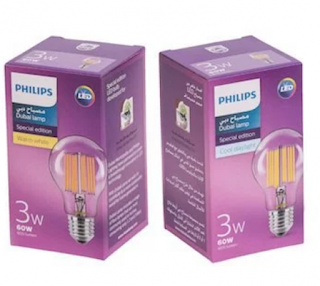








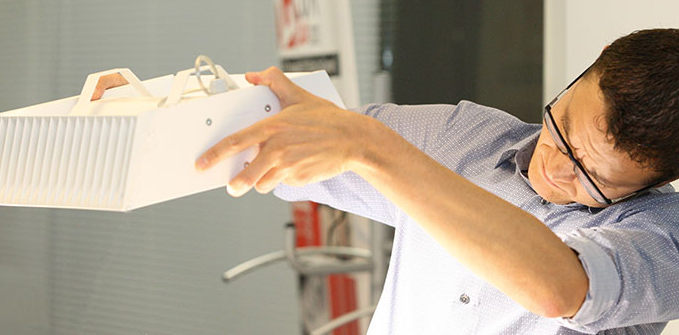


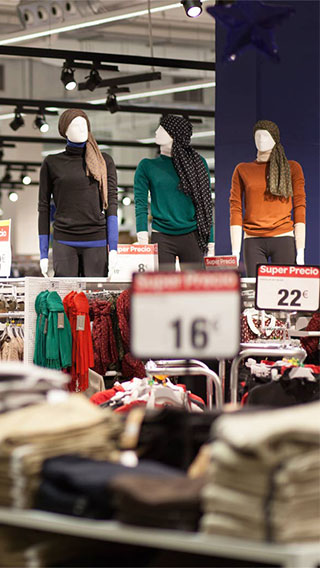
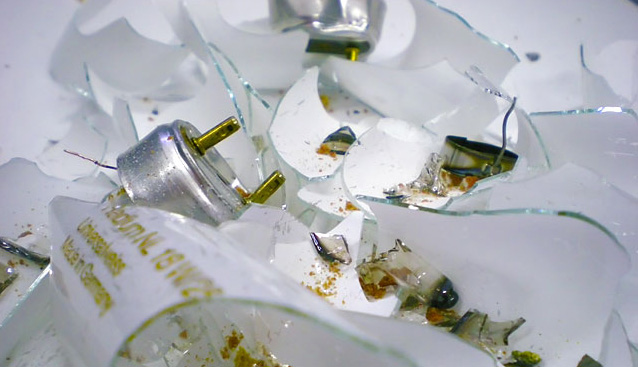
 In 2015 the number of lamps being recycled leapt by 44 per cent while luminaires were up 4.4 per cent. Commenting on the news, Nigel Harvey, CEO of specialist lighting WEEE compliance scheme Recolight, said: ‘It is particularly pleasing to see that the 2015 recycling rate bounced back up from 2014. This is probably due, in part, to the recycling of fluorescent waste resulting from major LED integrated luminaire roll outs in business premises across the UK. The lamp recycling rate from 2013 to 2014 saw a drop when, for the first time, the data included LED lamps as well as Gas Discharge Lamps. With very large quantities of LEDs being sold – but very few being returned as WEEE, the inclusion of LEDs inevitably reduced the rate.’
In 2015 the number of lamps being recycled leapt by 44 per cent while luminaires were up 4.4 per cent. Commenting on the news, Nigel Harvey, CEO of specialist lighting WEEE compliance scheme Recolight, said: ‘It is particularly pleasing to see that the 2015 recycling rate bounced back up from 2014. This is probably due, in part, to the recycling of fluorescent waste resulting from major LED integrated luminaire roll outs in business premises across the UK. The lamp recycling rate from 2013 to 2014 saw a drop when, for the first time, the data included LED lamps as well as Gas Discharge Lamps. With very large quantities of LEDs being sold – but very few being returned as WEEE, the inclusion of LEDs inevitably reduced the rate.’